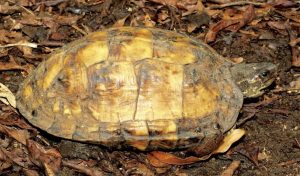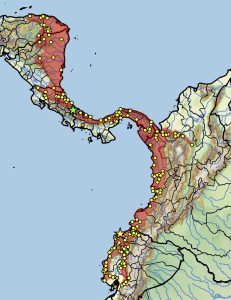Rhinoclemmys annulata, 123
Rhinoclemmys annulata (Gray 1860) –
Brown Wood Turtle, Montañero, Bambera
John L. Carr1,2, Don Moll3, Alan Giraldo2, and Mario F. Garcés-Restrepo2
1Biology–School of Sciences, University of Louisiana Monroe, Monroe, Louisiana 71209 USA [[email protected]];
2Universidad del Valle, Facultad de Ciencias Naturales y Exactas, Departamento de Biología,
Sección de Zoología, Grupo de Investigación en Ecología Animal, Cali, Colombia
[[email protected], [email protected]];
3Department of Biology,, Missouri State University, Springfield, Missouri 65897 USA [Deceased]
Summary. – The Brown Wood Turtle, Rhinoclemmys annulata (family Geoemydidae, subfamily Rhinoclemmydinae), is a medium-sized turtle (maximum straightline carapace length [SCL] to 226 mm), that is largely terrestrial and primarily occurs in rainforest areas in Caribbean drainages of Central America from Honduras to northern Colombia, and in Pacific drainages from eastern Panama south to Ecuador. In Ecuador, the species occurs in dry forest areas as well. The known elevational range is from sea level to 920 m. The species is monotypic, without subspecies, and demonstrates substantial variability in carapace coloration within populations. There is modest sexual size dimorphism, with males reaching a maximum SCL of 202 mm, and females up to 226 mm. Females lay one large elongate egg measuring approximately 71 x 37 mm and 48–49 g, with a mean hatchling SCL of 63.9 mm. The ecology of R. annulata is poorly studied, and its population status is unknown. The greatest threat faced by this species is habitat destruction, although the degree and impact of this threat remains unknown. It is also sometimes utilized as a local pet and food source by several indigenous and rural populations. Trade into the international pet market appears to be minimal. The species has been recorded from several protected areas within its range, but assessments of its threats, conservation status, and population trends are needed.
Distribution. – Colombia, Costa Rica, Ecuador, Honduras, Nicaragua, and Panama.
Synonymy. – Geoclemmys annulata Gray 1860, Clemmys annulata, Rhinoclemys annulata, Rhinoclemys (Callopsis) annulata, Chelopus annulatus, Rhinoclemmys annulata, Nicoria annulata, Geoemyda annulata, Callopsis annulata, Chelopus gabbii Cope 1875, Emys gabbii, Nicoria gabbii, Geoemyda gabbii, Rhinoclemmys gabbii, Testudo mercatoria Vaillant 1911 (nomen nudum).
Subspecies. – None recognized.
Status. – IUCN 2022 Red List: Near Threatened (NT; assessed 1996); TFTSG Provisional Red List: Data Deficient (DD; 2011, 2018); CITES: Appendix II as Rhinoclemmys spp. (2023); Colombia Red List: Least Concern (LC; 2015); Costa Rica Red List: Least Concern (LC; 2014); Ecuador Red List: EN (Endangered; 2005); Nicaragua: Least Concern (LC; 2017).
Citation:
Carr, J.L., Moll, D., Giraldo, A., and Garcés-Restrepo, M.F. 2023. Rhinoclemmys annulata (Gray 1860) – Brown Wood Turtle, Montañero, Bambera. In: Rhodin, A.G.J., Iverson, J.B., van Dijk, P.P., Stanford, C.B., Goode, E.V., Buhlmann, K.A., and Mittermeier, R.A. (Eds.). Conservation Biology of Freshwater Turtles and Tortoises: A Compilation Project of the IUCN/SSC Tortoise and Freshwater Turtle Specialist Group. Chelonian Research Monographs 5(17):123.1–16. doi: 10.3854/crm.5.123.annulata.v1.2023; www.iucn-tftsg.org/cbftt/.
Adobe Acrobat 6.0 or later required)
Adult female Rhinoclemmys annulata from Tortuguero National Park, Costa Rica.
Photo by Michael Redmer.
Distribution:
Distribution of Rhinoclemmys annulata in southern Central America and northern South America (Honduras, Nicaragua, Costa Rica, Panama, Colombia, and Ecuador). Yellow dots = museum and literature occurrence records of native populations based on Iverson (1992), other more recent literature records (see TTWG 2021), and authors’ additional data; orange dots = possible trade or translocated specimens; yellow star = Geoclemmys annulata Gray 1860 type locality; green star = Chelopus gabbii Cope 1875 restricted type locality. Distribution based on fine-scaled GIS-defined level 12 HUCs (hydrologic unit compartments) constructed around verified localities and then adding HUCs that connect known point localities in the same watershed or physiographic region, and similar habitats and elevations as verified HUCs based on Buhlmann et al. (2009), TTWG (2017, 2021), and data from authors and other sources.










